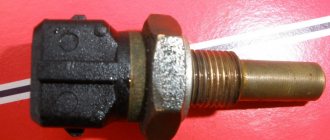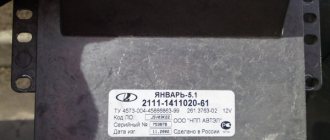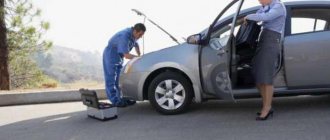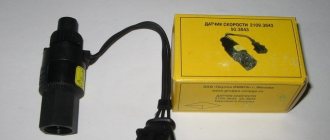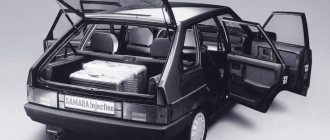Candles
First of all, find out if there is a spark at all. The weakness of the latter allows you to start the engine while it remains hot, but it does not work when it is cold.
Unscrew the spark plug, place it against ground and crank the starter. If there is a spark, then there is probably a problem in the fuel system. We will tell you about it later.
It is necessary to do otherwise when the unscrewed spark plug works properly, but it turns out to be wet. Here you should check the timing belt. The latter sometimes jumps off, which disrupts the correct gas distribution and, accordingly, the VAZ engine does not want to start.
If you see that the spark plugs are filled with fuel, then perhaps this very circumstance is preventing you from starting the engine. Dry them with a burner or on a gas stove burner. When they turn out to be wet again during the next attempt, you will have to find out why this happened.
If there is no spark, the cause is sought further. It often lies in problems:
- crankshaft pulley or sensor that controls its position (DCPV);
- computer.
In most cases, the VAZ model 2109 injector does not want to start precisely because of the failure of the DPKV. Failure of other sensors does not prevent the engine from starting, it will simply not work correctly.
First, check whether the connector leading to it is intact and whether the wires are in good condition. It is the destruction or contamination of these elements that most often interferes with the normal operation of the DPKV, while the device itself is reliable.
To test the sensor, just hold a piece of metal close to it and measure the output voltage. It will fall if the piece of iron is taken away, and rise when it is brought close.
Another reason why a VAZ may not start is the crankshaft pulley. The disadvantage of this unit is that its teeth are partially made of rubber, which means they can come off or even scroll. This affects the sensor readings, and the computer, guided by them, does not want to supply voltage to the spark plugs. It’s not difficult to check - remove the casing from the timing belt (inspect it at the same time), and then examine the pulley.
There is a high probability that there is no spark due to a faulty ignition. First you should make sure that the connector leading to it is intact. Installing a known-good module on a Lada that does not want to start will allow you to confirm your suspicions.
It is imperative to inspect all wires. A break in them, even with working devices, often leads to the inability to start the engine.
Lada injection engine does not start
The injection model of the “nine” is 21093i. The reason why the VAZ 21093 does not start may also be flooded spark plugs, a slippage of the timing belt, a seated battery, etc. Failures of the injection engine, due to which it does not start hot or cold, may also be due to the peculiarities of the injector design. The lack of a spark can be caused by a breakdown of the crankshaft position sensor (CPS), crankshaft pulley, ignition module, or electronic control unit (ECU).
The risk of breakdown of the injection motor is a large number of sensors. But the VAZ 2109 can fail to start only due to a breakdown of the DPKV. If other sensors fail, the car will start. We remove the DPKV, check the integrity of the connector and the presence of dirt on it. Then we supply power to it from the battery and bring the metal to the working area. The output voltage should increase, and when metal is removed, it should tend to zero. If this does not happen, change the DPKV.
The reason may be that the rubber part of the crankshaft pulley with teeth on the DPKV falls off or rotates. The sensor does not work and the ECU does not instruct to send a spark. At the same time, we check the ECU and the contacts of all wiring. We've already checked this, everything is fine, but why won't the car start?
We check whether fuel is supplied to the injectors. To do this, loosen one of the supply pipes and turn the key in the lock; fuel should spray out of the pipe. At the same time, we measure the pressure in the fuel rail and connect a pressure gauge to it through a special tap. The norm is within 4 atm. An indicator below the norm indicates that the fuel pump is not working well or the fuel filter is clogged, and a sufficient amount of gasoline is not supplied to the injectors.
The injectors themselves may also be clogged. As a result, gasoline does not spray under pressure, but drips, and in cold weather such an engine may not start. The injectors do not spray fuel without a signal from the ECU. You need to make sure that the electronics chips are mounted on the injectors and that the wiring is intact.
Another disadvantage of frost for an injection engine: the timing teeth are cut or slipped. If the car does not start in cold weather, it is a good idea to remove the casing and make sure that the marks on the camshaft wheel and the flywheel shaft match. In rare cases, in cold weather, the injection VAZ 2109 may not start due to the connected temperature sensor.
Another rare case: shedding of the catalyst inside the muffler of the car. To check, loosen the clamp between the muffler and the catalyst. After completing all these steps, the injection Lada should start working.
Fuel system
If there is a spark in a carburetor or injection engine, it should be assumed that the car does not start due to problems in the fuel supply system.
First make sure that gasoline is flowing into the injectors. If not, then look at the VAZ fuel pump. It is equipped with an electric motor and is located directly in the tank. Normally, when the ignition is activated, it starts to make noise.
It is advisable to find out whether the pressure in the ramp is normal. Measure it with a pressure gauge - there is a special fitting for it. Connect the device to it - if the reading is 4 atmospheres, then everything is in order. Low pressure appears due to a clogged fuel filter; this element will have to be removed and cleaned.
If there is no positive result, move on to the injectors. When they become clogged, gasoline either stops flowing altogether or its volume noticeably decreases. Moreover, it does not spray, but only drips. This problem does not make itself felt while the engine is hot. In frosty weather, the car, even if it starts moving, will still not be able to develop normal power.
In addition, fuel atomization does not occur when the computer does not open the injectors. Make sure they have all the wires and are securely attached.
Spark plug
Try to always monitor the technical condition of the car. Indeed, in the case when the VAZ 21093 engine (injector) stops starting, it turns out that the owner simply did not keep an eye on it. Replace all consumables - filters, spark plugs, fluids - in a timely manner. Only in this case are you guaranteed stable and reliable operation of the motor. And anything can happen to these elements.
Firstly, with a long mileage, the electrodes begin to wear out. The central (positive) is erased to such an extent that the gap doubles. Secondly, be sure to keep an eye on the color of the electrodes, it will tell you a lot about the condition of the engine. Thirdly, they may simply be flooded as a result of the fact that you tried unsuccessfully and for a long time to start the engine.
Muffler
Sometimes an injection car does not want to start due to shedding of the catalyst in the muffler. It serves to reduce harmful emissions and is installed in accordance with current environmental legislation on all cars.
When the catalyst crumbles, the gases cannot escape normally, which means that the car will not move, since the computer will not allow it to start. It is not difficult to check this possibility - unscrew the muffler mount so that the exhaust comes directly from the resonator. If this helps, then change the catalyst.
Other problems
Both on the carburetor and on the injector, the main reason that prevents the engine from starting is problems with the starter. If it does not rotate, then you will have to figure out why. Possible breakdowns:
- winding break;
- solenoid relay failure;
- poor contact in the wiring;
- discharged battery.
Also, the car may not start due to lack of gasoline.
The ignition coil and lock will have to be checked if nothing else helps. When it turns out that the problem is in the first one, it is removed and replaced with a new one. In the second case, first of all, look to see if the wire has broken somewhere.
In the ignition system, the distributor is also a vulnerable element. Remove the cover from it - if it is damaged, replace it. You need to do the same with the slider and hall sensor.
In winter, condensation sometimes freezes in the fuel rail. Warming up with a hairdryer or blowing with a compressor helps.
What to do if your car's fuel-injected engine won't start? What to do when, when you turn the key in the ignition, the starter turns, but the engine does not start. If the engine had a carburetor, then the situation with identifying breakdowns would be a little simpler. What is the situation with injection engines?
In an area where there are a sufficient number of auto repair shops and calling a tow truck is not a problem, solving the problem is not so difficult. But what if this is not possible? After all, there are times when you have to do everything yourself. In fact, many breakdowns that prevent the engine from starting can be fixed on your own.
Electrical wiring problems
Listen to whether the fuel pump is running when the ignition is turned on. If there is no characteristic sound, then check the fuses on the VAZ 21093 (injector). Namely, the one that is responsible for supplying power to the fuel pump and its electromagnetic relay. It would also be a good idea to check the presence of power to all sensors in the system. Check all vehicle wiring for breaks. But if everything is in order, and the car does not start, then most likely there is a glitch in the software installed in the ECU. In this case, you will have to contact a service station for a complete diagnosis and firmware update of the microcontroller.
Possible reasons why an injection engine does not start
Fuel system
It is necessary to diagnose the fuel supply system. In domestic fuel-injected cars, when the engine starts, you can hear a specific buzzing sound from the rear of the car. This sound indicates that the fuel pump is operating. Accordingly, if such a buzzing noise is not observed, most likely the problem lies in the pump.
You need to check the fuses that control the fuel pump, the main engine control relay and the fuel pump relay. In some cars of the VAZ family, fuses are hidden under the glove compartment, in others behind the heating panel cover on the passenger side. If the fuses are ok, check the relay.
You can touch it, and a specific click should sound. If the relay is also working properly, you need to check the pressure in the fuel system. The best way to do this is with a pressure gauge. If this is not possible, you will have to find a spool, which should be under a protective cap.
When you press it, you should feel pressure. Some models do not have a spool. Then you need to disconnect the fuel supply pipe. If the pump is working, then pressure should also be felt under your finger.
Possible causes may also be clogged fuel filters or fuel supply pipes. There may also be such a banal reason as lack of fuel in the tank.
If it turns out that all elements of the fuel system are in order, then the next thing you should pay attention to is the ignition system.
Ignition system
The main thing you need to be sure of is the presence of a good spark, that is, a discharge between the two contacts of the spark plug. If the starter turns, but the engine does not start, then there is a high probability of a malfunction in the ignition system. This is where we need our spark gap. If you check the spark plug without it, for example, by attaching it to the engine, then the resistance will be too high.
Therefore, we will not be able to accurately check our spark plugs and, in addition, the controller may be damaged. After checking the fuel system and ignition system and not finding the cause of the malfunction, you will need to check the engine. Most likely, this is the reason.
Starter malfunction
This can be a very common reason why the car engine does not start. In order to establish the possible cause of a starter failure, it is very good if the car enthusiast has at least an approximate understanding of the structure of this mechanism and how to check whether it is working.
It is important for owners of foreign cars to know that imported starters can stop turning even due to lack of lubrication or when dirty. In this case, the solution is very simple: remove the starter from the engine, thoroughly clean it from dirt and thoroughly lubricate the necessary mechanical components. Moreover, the used lubricant must be removed. In principle, this is not difficult, but if it doesn’t work out, then it’s better to contact a specialist.
Some starter malfunctions can be determined by ear. If you turn the key in the ignition switch, the starter makes a click, but it does not start, then most likely the relay is faulty. If possible, then you need to repair it. If the relay cannot be repaired, then it is worth replacing it. Only dismountable types of relays can be repaired.
Accumulator battery
The battery must be undamaged and the terminals clean and free of oxide, otherwise there will be no good contact between the battery and the vehicle's electrical wiring. The battery must have sufficient charge and “hold” it.
If the battery has been used for some time in undercharge mode, then there is a very high probability of deep discharge, in which it will no longer be able to recover.
Wiring
Corrosion may form on wiring elements or at connection points, which prevents the normal flow of current. All contact pairs must be clean and the connections insulated.
Injectors
Injectors in a car rarely fail all together and at the same time. Therefore, if there is a malfunction of one of the injectors, the engine will still be able to start and operate, albeit intermittently.
Crankshaft sensor
If this sensor is faulty, the engine will not be able to start. At the same time, the starter turns, but the engine still does not start. Failure of other sensors will not have such an impact that the engine will not start. To test the sensors, you should use a multimeter.
The start and operation of the VAZ-2109 engine is controlled by an electronic system. It processes the readings of many sensors that monitor various parameters. If any sensor fails, the injector either does not start or does not work correctly.
Step-by-step repair instructions
By following a certain sequence in your actions, you will eventually be able to determine on your own why the engine does not start or problems arise with it.
| Repair stage | Your actions |
| Turn the ignition key, check the starter | If the key turns and the starter turns, then this is definitely not the reason. Even if the engine doesn't start. A failure of the starter indicates the need to replace it. |
| Check the fuel level in the tank | You should not rely only on the sensor readings. He sometimes cheats. More than once it happened that a car owner went through almost the entire car, rebuilt the carburetor, and in the end it turned out that the fuel had simply run out. It may be funny, but it’s still worth checking for yourself that there is fuel in the gas tank. |
| Make sure there is spark | Remove any of the spark plugs, connect to the high voltage wire and touch ground (engine). You will need a partner to sit behind the wheel and turn the starter. If a spark appears at the tip, everything is fine. Is she not there? Blame the switching unit and replace the switch with a new one. |
| Check for spark on the center wire from the coil | A test method similar to the spark plug is used. If no spark is detected, most likely the coil has failed. Replace element |
| Assess the state of the power system | If it's freezing outside, there may be water in the gasoline, which eventually turns into ice. To check this, open the air valve and press the fuel pump button several times. The sound of gurgling sounds indicates that gasoline is flowing to the carburetor. The absence of rolls will not allow starting the carburetor when cold, since the fuel is partially frozen. You'll have to change the fuel pump here. |
| Fine filter | Look at the condition of the filter. If cracks, damage and other visible defects appear on it, the element will have to be replaced |
| Gasoline supply hoses | Make sure that the hoses supplying gasoline from the pump to the engine are intact. In case of defects, damage, cracks, they must be replaced with new ones. |
| Spark plug | We've already checked the spark. Now unscrew all the spark plugs and inspect them for traces of carbon deposits. If the spark plugs turn out to be black from soot or filled with gasoline, there is no point in cleaning the units with ordinary sandpaper. You will not achieve the desired effect. The only recovery solution is to heat them on a gas stove. If you don't want to try this method, just install a new set of quality spark plugs |
| Distributor high voltage wires | Remove them and check for integrity and absence of damage. If there are any, buy a new set and install it on the car |
| Distributor cover | The presence of chips and scorched contacts inside it indicates wear and loss of functionality. There is only one way out - change devices. It is worth changing the slider at the same time as the lid. |
| Hall Sensor | Quite often the carburetor does not start precisely because of a faulty Hall sensor. It is held on the distributor with two bolts. Unscrew the fasteners, disconnect the wires and replace the old sensor with a new one. Put everything back together, check the carburetor's functionality |
| Location of distributor high voltages | It is not uncommon for inattentive craftsmen or inexperienced craftsmen who repair their car themselves to make mistakes when reassembling the distributor. High voltage wires must have a specific connection. The wire marked on the cover with the number 1 comes from the leftmost (first) cylinder, then clockwise goes cylinder 2, then 4, and only then 3. If you mix up the location, the car will start to shake wildly or you will not be able to start the carburetor at all |
| Timing belt | You can find the timing belt on the left under the casing. Remove it and evaluate the condition of the belt teeth. If they are partially loose or fall off, it is better to replace the belt with a new one. It is also possible that the valves on the 1.3-liter engine were bent. It is strongly not recommended to resolve this issue on your own. |
- If a step-by-step check of each component of the VAZ 2109 car did not allow you to find the answer to why the carburetor cannot start properly, you will have to go to a service station.
- Practice shows that a detailed inspection of the machine’s components and replacement of worn-out, damaged elements immediately returns the carburetor to its previous functionality; it starts without problems both cold and hot.
VAZ-2109 does not start - what to do?
In general, diagnosing malfunctions of the controller (computer) and control system sensors, as well as the VAZ-2109 injector itself, is not much different from similar work for other cars. But due to the peculiarities of the “nine” control system, experienced owners of this car recommend the following solutions.
Most often, the injection “nine” does not start in winter. In this case, it is advisable to warm up and even recharge the battery - perhaps due to loss of capacity due to low temperature, it is not able to spin the engine shaft well.
Another “folk” method that helps is supplying air to the engine filter through a hairdryer. At the same time, heated air will flow into the cylinders. Many people claim that the VAZ starts right away.
Another possible reason: as a result of prolonged unsuccessful attempts to start, the spark plugs were filled with gasoline. In this case, it is recommended to try to start the car with the gas pedal pressed all the way to the floor - the spark plugs should dry out and the car will start. If this does not help, then unscrew the spark plugs and check for the presence of a spark. If it is not there, then either the spark plugs or the ignition system are faulty.
Differences between carburetor and injector breakdowns
There are common cases of engine starting failure for the injector and carburetor. But now let’s look at the distinctive features of such a malfunction as a “stalled engine”. The differences in troubleshooting are due to the different operating principles of the two systems.
The VAZ 2109 has a carburetor - the engine is driven by sucking the combustible mixture into it. This occurs due to the fact that a pressure difference is formed in the intake manifold and the atmosphere.
In this case, three components are sufficient to start the machine normally:
- gasoline;
- air;
- sparks.
The starter rotates the crankshaft, and the resulting mixture (fuel and air) is sucked into the cylinder cavity. Next, the valves of the internal combustion engine close, a compression stroke occurs, at the end of which a spark appears on the spark plug and the combustible mixture is ignited. The engine starts.
And in the case of an injector, fuel injection and the quality of the resulting mixture are controlled and adjustable. The combustible mixture is pumped into the cylinders using nozzles (directly into the combustion chamber). Therefore, there is no need to create conditions for the absorption of air and gasoline here.
A breakdown in an injection engine can be briefly described as follows: either a spark does not form, or access to the cylinders is blocked for the combustible mixture.
In addition, the VAZ 2109 injector has many sensors, an electronic control unit and an electric fuel pump. They can also fail. Let's consider the procedure for finding a breakdown separately for the carburetor and injector.
Checking injectors and timing belt
When there is a spark and its color is bright bluish, check the fuel supply: turn out the injectors and turn the engine shaft with the starter. The fuel should be sprayed from the nozzle in a uniform cone-shaped “torch”. If instead the injector pours gasoline or splashes it, then it is clogged.
If the tested components are working, then look at the timing belt. Owners of the injection “nine” have more than once encountered the situation of the belt slipping by several teeth. In winter, this can happen when starting a cold engine when the camshaft rotates heavily. To check, look at the timing mark. If it matches, check the crankshaft sensor and its wire (sometimes it comes off). Then the remaining sensors are checked.
Timing Belt
Anything can happen to this element. Firstly, the belt tends to break, and this happens at the most inopportune moment. It is worth noting that on 1.5-liter engines, fortunately, a broken belt does not end with bending the valves or repairing the cylinder head. but more trouble may arise if the timing belt simply jumped 1-2 teeth. This happens when the belt is loose. To make sure the settings are correct, you need to see if the marks on the camshaft and crankshaft match. But if the VAZ 21093 engine (injector) does not start, be sure to check the crankshaft position sensor and its connection wire. This device must first be diagnosed.
Diagnosis of sensor failure
Let's consider deviations in engine operation and the corresponding possible causes. Unstable operation at idle, difficult starting or stopping the engine after driving in high power mode can be caused by malfunctions of the mass air flow sensor (MAF) - it will give the controller at low speeds readings that are 15–25% higher. If there is excessive fuel consumption or the engine response has decreased, the mass air flow sensor gives underestimated readings.
Jerks and dips when switching from idle to operating speeds, even in the case of light loads, means that the operation of the sensor that reads the throttle position has been disrupted. Difficulty starting a warm engine or slight excess fuel consumption - the coolant temperature sensor has failed.
The engine picks up speed poorly and does not develop the required power, or there is a large excess fuel consumption - the knock sensor has failed or the wire from it has broken. In the event of a noticeable overconsumption of fuel with a simultaneous increase in the amount of harmful emissions in the exhaust gases, the oxygen sensor has failed.
A slight decrease in throttle response and deterioration in other engine performance characteristics means a failure of the speed sensor or oxidation of the contacts of its wires or connector. Limiting engine speed or stopping it indicates a failure of the crankshaft position sensor. Large excess fuel consumption - the phase sensor has failed. Minor deterioration in engine performance or difficult starting means the temperature sensor of the air entering the engine has failed.
If all of the above devices and sensors have been checked, but the injection VAZ-2109 does not start, then the processor may have failed and it does not properly control the entire starting system. In this case, diagnostics at a car service center is required.
Home → Device → Fuel and exhaust systems → Fuel injection system →
The problem is not new and does not lose its relevance when the VAZ 21093 injector does not start, having previously worked faithfully for several years.
The suddenness of such a situation can baffle even an experienced driver. Until 1998, while the “nine” was equipped with a carburetor engine, the problem was dealt with successfully, and there were only two reasons for not starting - a lack of gasoline and soot from the spark plugs. Since 1998, the VAZ 2109 became fuel-injected
, which began to put motorists in a certain uncomfortable position, especially those who did not use injection engines. The VAZ 21093 injector does not start for reasons, the list of which is much longer than could be compiled for the carburetor version. At first glance, it seemed that the problems should have decreased, but they only increased.
Changing antifreeze on Lada 2109: technology and frequency of work
- When should you think about replacing?
- Required accessories
- DIY technology for replacing antifreeze on injection VAZ 2109
- Features of coolant replacement technology
- Briefly about replacement
When should you think about replacing?
The schedule approved by the manufacturer indicates that the replacement of antifreeze on a VAZ 2109 should be carried out:
- Once every three years, regardless of mileage;
- every 60 thousand km. mileage regardless of operating time.
The expediency of carrying out the operation is relevant when carrying out repair and restoration work with elements of the “cooling” circuit, preparation for which involves draining the coolant. Such work may include replacement:
- heater radiator or cooling system heat exchanger;
- thermostat;
- expansion tank;
- centrifugal pump;
- antifreeze temperature sensor.
Experienced mechanics do not recommend delaying the process of changing antifreeze for a long time. The loss of anti-corrosion and detergent properties, a decrease in the density of the liquid can lead to serious consequences, requiring significantly larger investments than the operation of replacing the coolant.
Required accessories
Maintenance of the engine cooling system is possible with at least 8 liters of special composition. In the service book, Lada specialists display a list of suitable coolants:
- Antifreeze AM;
- "OZHK LENA";
- "LENA-40";
- Antifreeze A-40M;
- SPEKTROL ANTIFREEZE;
- AGIP ANTIFREEZE EXTRA;
- Glisantin G 03.
The accessories are an open-end wrench set to “13”, a screwdriver and a container for draining antifreeze with a volume of at least 8 liters.
DIY technology for replacing antifreeze on injection VAZ 2109
The replacement concept involves draining the used compound through special holes and filling the system with new antifreeze. The designers provide two drain holes in the cooling system of VAZ engines:
- on the left side of the main radiator;
- on the front wall of the cylinder block.
Replacing antifreeze on VAZ 2109 engines is not possible without first dismantling the ignition module located on the front surface of the cylinder block:
- remove the negative terminal from the battery;
- disconnect the wires from the spark plugs;
- remove the ignition module power supply block;
- unscrew the bolts securing the module relative to the cylinder block and clutch housing;
- loosen the upper left bolt of the front engine mount;
- remove the module bracket from under the bolt;
- remove the module with wires from the engine compartment.
Draining of used antifreeze is carried out according to the following method:
- open the heater tap;
- connect the expansion tank to the atmosphere by unscrewing the cap (under such conditions, rapid flow of liquid from the system is ensured);
- place the container and unscrew the cap in the lower left corner of the engine radiator, wait for the liquid to drain;
- Unscrew the drain nut on the cylinder block and drain the coolant from the “jacket”.
For your information. If the drained liquid is dirty and rich in various inclusions, the system should be flushed with plain water:
- clog the drain holes;
- pour water through the expansion tank and close it;
- start the engine for 3-4 minutes;
- shut down and drain.
The operation is repeated until the waste water is clean.
Having removed all the liquid from the system, you should:
- install all drain fittings back;
- install the ignition module in reverse order;
- connect the vehicle's ground to the battery;
- pour new antifreeze through the expansion tank (see filling technology below);
- start the engine for 1-2 minutes;
- add coolant and close the expansion tank;
- warm up the engine until the cooling fan operates and turn off;
- if necessary, add coolant to the virtual average mark (between MIN and MAX).
Features of coolant replacement technology
- the coolant temperature arrow is approaching the red zone, and the cooling fan has not worked and cold air is blowing from the heater - there is an air lock in the system;
- hot air comes from the stove, but the fan does not work at the set temperature (about 105-107 degrees) - the fan is faulty;
- The fluid level in the expansion tank tends to increase.
The correct method of filling the system with liquid will help to avoid the appearance of an air lock:
- pour antifreeze into the expansion tank (full filling of the container is allowed);
- disconnect the compound supply hose from the throttle assembly heating fitting;
- add the composition as the expansion tank is emptied;
- if there is a phenomenon of liquid leakage from the heating fitting of the throttle assembly, put on the antifreeze supply hose (you may need to create a slight pressure in the tank (one or two deep exhalations into the tank are enough);
- close the tank.
Briefly about replacement
The process of replacing antifreeze on VAZ 2109 engines is carried out either once every three years, or once every 60 thousand km, or (advisable) when carrying out repair work on cooling system units. The operation route looks like this:
- remove the ignition module (on injection models);
- drain the used antifreeze;
- Having disconnected the coolant supply hose to the throttle assembly (injector) or to the carburetor, fill in a new mixture through the expansion tank;
- start the engine for 1-2 minutes;
- check and, if necessary, add antifreeze;
- start and warm up the engine to the fan operating temperature (105-107 degrees);
- turn off the engine, inspect the system for leaks, and if necessary, add antifreeze to the medium level.
Content
The quantity and quality of the fuel mixture in the injector is controlled electronically. Sensors are located throughout the engine unit, the signals from which are intercepted from the microprocessor and converted to the fuel supply system. The same processor controls the mixture ignition system in the combustion chamber
.If any sensor malfunctions, the output control pulse ceases to correspond to the parameters of the normal functioning of the engine, and it refuses to work, in other words, it does not start.
Problems with starting the injector on the 2109 especially manifest themselves in winter, on cars that while away the nights in cold garages and “in an open field.” The morning for them begins with a long warm-up. However, after being in the cold
, the battery loses all its performance and requires recharging. That is why most motorists take the battery with them to a warm apartment in winter. Particularly advanced motorists place a hairdryer under the air filter, trying to supply warm air to the cylinders and give the engine “artificial respiration” - they say this can help. {banner_content}
Spark plugs are the next most likely cause of a failure to start the engine. After repeated attempts to start, they simply drown in fuel, as drivers say: the spark plugs are flooded. Experienced car enthusiasts recommend that in such a situation, press the gas pedal to the floor and turn on the ignition
, after such manipulation the spark plugs dry out and begin to produce a normal spark. Sources used:
- https://ladaprofi.ru/vaz-2109/chto-delat-esli-vaz-2109-ne-zavoditsya.html
- https://avtodvigateli.com/neispravnosti/ne-zavoditsya-inzhektornyj.html
- https://carnovato.ru/inzhektor-vaz-2109/
- https://autoflit.ru/278-ne-zavoditsya-vaz-21093-inzhektor-osnovnye-prichiny-i-sposoby-pochinki.html
Injectors: diagnostics
When it has been determined that there is a spark between the electrodes (and it is bright blue), the gaps are normal, but the engine still does not start, you need to check the injectors. These are devices that inject a fuel-air mixture into the combustion chambers of each engine cylinder. If the VAZ 21093 engine (injector) does not start, the likelihood that the injectors are malfunctioning is extremely high.
To check the fuel injectors, you will need to have diagnostic equipment. But this is for an accurate check. To, as they say, “by eye” determine serviceability, you can remove the nozzle and connect it to the power supply. The ideal form of spraying the air-fuel mixture is a cone-shaped torch. And if fuel flows or drips with difficulty from the nozzle, we can say that contamination has occurred. Cleaning the spray nozzles will help you in this case.


